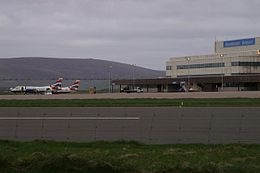Difference between revisions of "Sumburgh Airport"
(→Incidents and accidents) |
|||
| Line 9: | Line 9: | ||
|latitude=59.881389 | |latitude=59.881389 | ||
|longitude=-1.293889 | |longitude=-1.293889 | ||
| + | |type=Public | ||
|website=[http://www.hial.co.uk/sumburgh-airport/ Sumburgh Airport] | |website=[http://www.hial.co.uk/sumburgh-airport/ Sumburgh Airport] | ||
}} | }} | ||
Latest revision as of 22:43, 20 February 2020
| Sumburgh Airport | |
| Code | IATA: LSI, ICAO: EGPB |
|---|---|
| County | Shetland |
| Public | |
| Location | HU395108 59°52’53"N, 1°17’38"W |
| Website | Sumburgh Airport |
Sumburgh Airport (IATA: LSI, ICAO: EGPB) is the main airport serving the isles of Shetland. It sits on the southern tip of Mainland, 17 nautical miles south of Lerwick. The airport is owned by Highlands and Islands Airports Limited (HIAL) and served by Loganair (under franchise to FlyBe) as well as sometimes seasonally by Atlantic Airways.
The airport is unusual in that it has a 1,804 ft helicopter runway as opposed to usual helipad. The western end of runway 09 crosses the A970 road between Sumburgh and the northern mainland; access is controlled by a level crossing with barriers lowered whenever a flight is taking off or landing.
HIAL receives subsidies from the taxpayer in accordance with Section 34 of the Civil Aviation Act 1982.
Contents
History
Sumburgh Links was surveyed and the grass strips laid out by Capt E E Fresson in 1936 and the airport was opened on 3 June of that year with the inaugural flight from Aberdeen (Kintore) by the De Havilland Dragon Rapide G-ACPN piloted by Fresson himself. It was also one of the first airfields to have RDF facilities due to the frequency of low cloud and fog coupled with the proximity of Sumburgh Head. The building of runways was at the instigation of Capt Fresson who had proved to the Navy at Hatson that to maintain all round landing facilities over the winter months runways were essential. This was taken up by the Royal Air Force after the obvious success of the Hatson (Orkney) experiment.
The former RAF Sumburgh airfield had two runways, the longest being 800 yards, and the shorter running a length of 600 yards from shore-line to shore-line. No. 404 Squadron operated Beaufighter Mark VI and X aircraft from this station on coastal raids against Axis shipping off the coast of Norway and in the North Sea.
Airlines and destinations
| Directflight: | Seasonal: Fair Isle |
| Flybe: | Aberdeen, Edinburgh, Glasgow International, Inverness, Kirkwall |
| Flybe: | Seasonal: Bergen Charter: Knock |
| Oil rigs by helicopter |
Other tenants
- Maritime and Coastguard Agency (Her Majesty's Coastguard)
- Bristow Helicopters
- Bond Helicopters (Private SAR for BP)
Incidents and accidents
- The Air Accidents Investigation Branch recommended a safety audit of City Star Airlines after a serious incident in which a Dornier 328 crew flew close to cliffs and failed to respond correctly to terrain warnings on approach to Sumburgh Airport after a flight from Aberdeen.
- 31 July 1979 at Sumburgh Airport a Hawker Siddeley 748 series 1 (registration G-BEKF) operating an oil industry support flight crashed. The aircraft failed to become airborne and crashed into the sea, due to the elevator gust-lock having become re-engaged.
- 6 November 1986. A Boeing 234LR Chinook helicopter crashed 2.5 miles northeast of the airport. Only two people survived with 45 lives being lost.
- On 29 March 1981 Potez 840 F-BMCY operated by Club Aéronautique de Paris made a wheels-up landing at Sumburgh. Damage was minimal and the aircraft was parked on a stand for many months. However, then the four Astazou engines and other useful parts were removed and the airframe dragged off to a quiet corner of the airfield to be abandoned. When the runway was extended it was saved and now resides in a private garden in North Roe in the north of Shetland. Only 8 Potez 840s were built.
Outside links
- Sumburgh Airport
- Shetlopedia: Sumburgh Airport
- Photographs of aircraft at Sumburgh Airport
- Information on Second World War aircraft that crashed in and around Shetland
